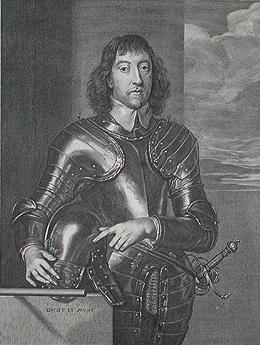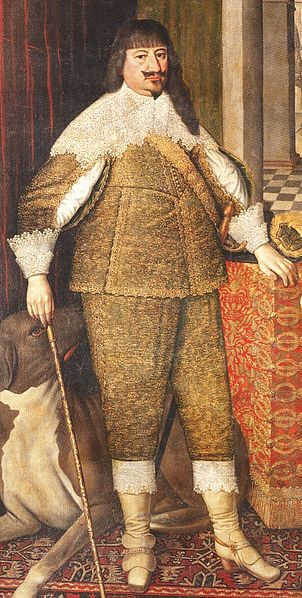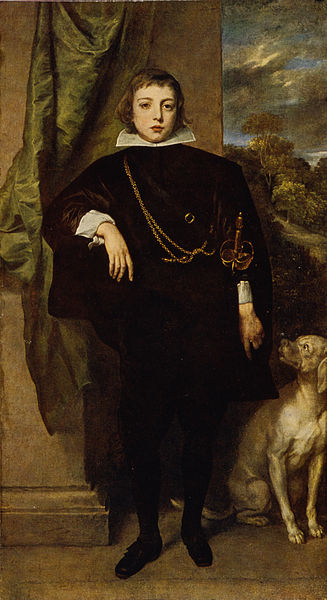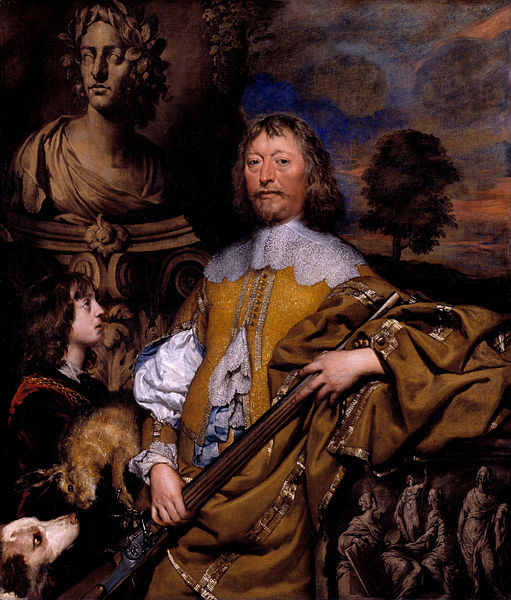.jpg/775px-Siege_of_Breda_in_1637_by_Frederick_Henry_-_Breda_Obsessa_et_Expvgnata_(J.Blaeu).jpg) |
| Siege of Breda |
Fortune’s Son
During
Charles Louis and Rupert’s visit to England their uncle sponsored a fundraising
drive to equip an army to assist Charles Louis to regain his Electorate. Both
Charles and Lord Craven pledged £10,000[i].
On their
return home the two boys were to see action at the siege of Breda; one night Charles Louis and Rupert
slipped up to the city walls and overheard talk of a surprise attack on the
besiegers. When the Spanish launched their attack they were met by ordered
ranks of musketeers. On another occasion when the Dutch army was attacking the
fort Rupert, despite orders to the contrary, was one of the first to breach the
walls. The successful assault returned Breda back to Dutch control[ii] .
 |
| General von Konigsmark |
While his
younger brother Maurice was sent to finish his education in France, Rupert, now
17, joined Charles Louis in Westphalia. Charles Louis had gathered together
around 4,000 men, including Swedish and English contingents, insufficient for
the task in hand. Rupert was in charge of one of the three Palatine cavalry
regiments.
Rupert’s men
were involved in a skirmish near Rheine, being attacked by a force twice the size. Rupert ordered a charge and
the enemy were routed;
‘[The charge] was so
exemplary to all about him, that notwithstanding their odds of number, they
beat them into their garrison, and followed them so close that they wanted very
little of entering the town with the enemy.’[iii]
But the
position of Charles Louis’s army was now known to an Imperial force under
General Hartzfeldt who forced a battle at Vlotho on 17th October 1638. Rupert was taken
prisoner as the bulk of Charles Louis’s troops fled with their general von Königsmark.
Prisoner of War
 |
| Linz |
 |
| Henry Howard, Earl of Arundel |
‘One of the brightest
beauties of her age, no less excelling in the charms of her mind than of her
fair body.’[iv]
Rupert
received a visit from the emperor’s brother Archduke Leopold who recommended
that Rupert’s confinement be relaxed. Rupert was allowed to play tennis and
shoot. The English ambassador at Vienna, Henry Howard the Earl of Arundel, sent Rupert a white poodle Rupert
named Boy. He also made a pet of a young hare that followed him
everywhere. Eventually Rupert was allowed out of the castle grounds to hunt.
Further visits from Leopold resulted in the two becoming friends.
Return to England
Charles sent
Sir Thomas Roe, a devotee of his sister’s, to plead for Rupert’s freedom. Charles
increased the pressure to release his nephew who was wanted to fight in the
conflict now looming in England. Ferdinand’s wife Maria Anna pleaded
Rupert’s case. Rupert was eventually released in the autumn of 1641 after
promising never to fight against the emperor again.
Rupert took
the long way back to England via Vienna where he visited the imperial court; Rupert met Ferdinand who played
tennis and hunted with his guest. Rupert then visited Dresden to meet the Elector John George of Saxony, then on to Cologne before arriving at his birthplace in Prague.
 |
| Gustavus Adolphus with his sister Elizabeth |
Rupert
arrived in the Hague, joining his family not long before his youngest brother Gustavus Adolphus died on 9th January 1642 close
to his ninth birthday. His sister Sophie[v] later recalled that at the autopsy
that;
‘On opening him stones were
found in his bladder, one of which was the size of a pigeon’s egg surrounded by
four others that were pointed, and one in his kidneys in the shape of a large
tooth.’[vi]
Gustavus had
been in pain for most of his life. Rupert stayed in the Hague with his family
for two months; he spent his time assisting his sister Elizabeth[vii] with her scientific experiments and
supporting his mother through her grief.
The Winds of War
 |
| Princess Mary and Prince William |
Rupert
sailed to England in February, meeting Uncle Charles at Dover. Charles was
bidding au revoir to Henrietta Maria who was accompanying their daughter Mary[ix] to marry William, the second son of the Prince of
Orange. The queen was planning to hock the crown jewels to raise money for the
upcoming fight with parliament and purchase arms; Charles had already sold the
silver plate from Windsor Castle.
Charles was
pleased to see Rupert but explained that the presence of an experienced
military man like his nephew increased the likelihood of war and asked Rupert
to return to Holland. Rupert did as he was asked and accompanied his aunt and
cousin back home where he assisted Henrietta Maria with her military shopping
list.
 |
| Nottingham |
‘The seas contributed to the
designes of the prince, yet his mind went faster than his vessel. And the Zeale
hee had speedily to serve the King, made him think dilligence was lazy.’[x]
Maurice and
Rupert made haste to Nottingham. Rupert was present when Charles
raised his standard on 22nd August 1642, signifying his declaration
of war upon parliament. He also made Rupert a Knight of the Garter.
A Coveted Role
 |
| Robert Bertie, Earl of Lindsey |
Neither of
these two elderly gentlemen can have been impressed by the self-confident
twenty-two year old accompanied by his younger brother as well as his own
military engineer Bernard de Gomme among other military advisers
including the ‘fireworker’ Bartholomew la Roche and Daniel O’Neill.
Rupert took
over command of the cavalry, a much coveted post, from Lord Wilmot who became Rupert’s second in
command. His lack of experience gave rise to resentment from career soldiers
lacking Rupert’s family connections. Rupert needed to mould his uncle’s ragbag
collection of mounted soldiers into a disciplined force.
‘I shall tomorrow appear
before your town, in such a posture, with horse, foot and cannon, to make you
know it is more safe than to resist His Majesty’s command.’[xiii]
Wounded
sensibilities had to be smoothed over and the king had to write to the City of Leicester
apologising for his nephew’s misstep. Rupert’s gaffe played into the hands of
the Parliamentarians who condemned Rupert and his family for being ungrateful
for the assistance rendered them by England’s Protestants. The Parliamentarian
propagandists presented Rupert to the public as the epitome of an immoral
soldier. And it was now that the term cavalier became used to demonise the
royalist forces.
Bibliography
Prince
Rupert of the Rhine – Maurice Ashley, Purnell Book Services Ltd 1976
The English
Civil War – Robert Ashton, Weidenfeld & Nicholson 1989
The Memoirs
of Elizabeth Stuart Vol 1-2 – Elizabeth Benger, General Books LLC 2012
Charles the
First – John Bowles, Weidenfeld & Nicholson 1975
Charles I –
Christopher Hibbert, Penguin Books 2001
The Civil
Wars of England – John Kenyon, George Weidenfeld & Nicholson 1989
Prince
Rupert of the Rhine – Patrick Morrah, Constable & Company 1976
The English
Civil War – Diane Purkiss, Harper Perennial 2007
Prince
Rupert – Charles Spencer, Phoenix Paperback 2008
The Thirty
Years War – CV Wedgewood, Folio Society 1999
[i]
In 2013 the relative: historic standard of
living value of that income or
wealth is £1,449,000.00 economic status
value of that income or wealth is £50,470,000.00 economic power value of that income or wealth is £300,800,000.00 www.measuringworth.com
[iii]
Prince Rupert of the Rhine - Morrah
[iv]
Prince Rupert - Spencer
[vi]
Prince Rupert - Spencer
[viii]
To become an inveterate enemy of Rupert’s
[x]
Prince Rupert of the Rhine - Morrah
[xii]
In 2013 the relative: historic standard of
living value of that income or
wealth is £302,800.00 economic status
value of that income or wealth is £10,540,000.00 economic power value of that income or wealth is £62,880,000.00 www.measuringworth.com
[xiii]
Rupert of the Rhine - Ashley








